Don't wanna be here? Send us removal request.
Text
SEMIOTIC ANALYSIS OF CHOSEN WORK
‘Not too high, not too low my son’ by Clint Calleja, 2023

In this work, Calleja makes use of the myth of Daedalus and Icarus to symbolize the dangers of imbalance of his son's diabetes condition. This narrative is reinterpreted into a modrn context, where balance is not solely metaphorical but a literal necessity in managing his son’s Type 1 diabetes. Daedalus' advice to his son to maintain balance becomes a symbolic representation of the daily challenges involved in managing the blood sugar levels.
The life-sized representation of the artist's son emphasizes a personal narrative as well as reflects upon human fragility through its stark white representation- translating the mythological narrative into a personal experience.
The feautured mobile device that acts as a glucose monitor transforms its medicinal use into a modern reality. It highlights both control and the cyclical, never-ending care—to maintain balance.
I believe that with this link between ancient myth narative and modern medical reality- Calleja manages to create a strong, symbolic dialogue between the past and present; his son's fragility and resilience.
0 notes
Text
ECO-CRITICAL CRITICISM
'The Weather Project' by Olafur Eliasson, 2003.

Eliasson’s 'The Weather Project' is a compelling artwork that highlights human interaction with the environment. The topic of climate change is revealed through this project, highlighting human’s relationship with the weather and sun itself.
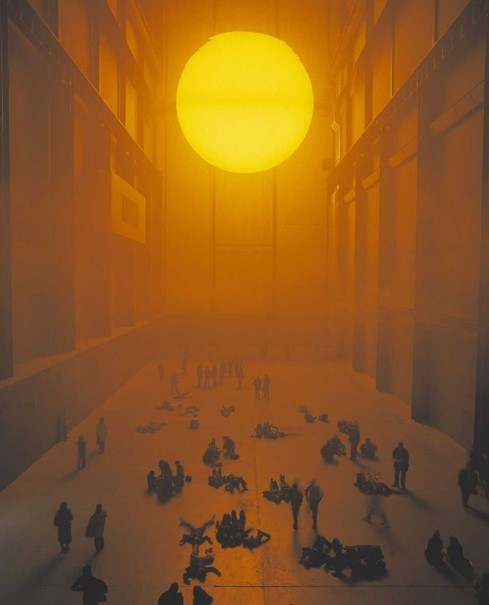
As a site-specific installation, it fills the space with a large orange sun that appears to rise from a misty sky- all of which are artificially created using light and mirrors to evoke an almost idyllic weather condition (Jiang, 2023). The reflective ceiling mirrors and the artificial sun create a surreal environment and a hazy atmosphere- allowing viewers to see themselves as small silhouette reflections against the glow (Bahadur, 2016).
This reflection highlights the viewer’s proximity to the sun- inviting them to reflect on the power of the sun in their lives. It also transforms the exhibition into a space for reflection- reinforcing the idea that climate change is not just an environmental issue but one that affects us directly (Jiang, 2023).
Whether intentional or not, I believe that Eliasson addresses the issue of climate change abstractly in his installation. His approach indirectly critiques the history of industrialization, with the exhibition itself being exhibited in London. This historical connection connects past industrial ideals with present issues of climate change- inviting the viewers to reflect on humanity’s ongoing impact around us (Jiang, 2023).
Bahadur, T. (2018). The Weather Project. [online] On Art and Aesthetics. Available at: https://onartandaesthetics.com/2016/04/25/the-weather-project/. Jiang, C. (2023). Olafur Eliasson’s The Weather Project – Confluence. [online] Nyu.edu. Available at: https://confluence.gallatin.nyu.edu/context/interdisciplinary-seminar/olafur-eliassons-the-weather-project#content [Accessed 23 Jan. 2025].
0 notes
Text
FEMINIST CRITICISM
'Is It Real? Yes, It Is!' by Juanita McNeely, 1969.

Juanita McNeely, a survivor of cancer and an illegal abortion, translated her real-life experience into her artistic work; ‘Is It Real? Yes, It Is!’ (Ludel, 2023). With its harsh realities of reproductive trauma, this artwork evaluates the systemic control over women’s reproductive rights.
The work is divided into panels that depict moments of the artist’s traumatic experience- immersing viewers in the terrifying experience of the artist’s illegal abortion. At first glance, the composition appears very chaotic and raw with all the explicit imagery that is used. However, I must say it is this graphic imagery which in turn elicits intense emotions - leaving one wondering how such brutal realities of women are often ignored by society.
McNeely depicts the female body in a fragmented and distorted form, most probably symbolizing the physical pain and emotional trauma. The skeletal imagery and dark colour palette might also symbolize this theme of survival. In connection to this, the juxtaposition of vibrant and muted tones may suggest misery and strength- challenging societal expectations by demanding recognition of women’s silenced realities. With this depiction, McNeely manages to reflect the work as a radical feminist statement- transforming something shameful to society into something rather powerful (Kreimer, 2020).
In this raw work, McNeely is not seen as a passive victim, but opposingly in power of sovcietal systems. The title itself-'Is It Real? Yes, It Is!', highlights the authentic lived experiences of such women- whilst demanding the need for their reproductive rights.
Kreimer, J. (2020). Juanita McNeely’s Multi-Panel Paintings Channel Harrowing Medical Traumas. [online] ARTnews.com. Available at: https://www.artnews.com/art-in-america/aia-reviews/juanita-mcneely-james-fuentes-medical-trauma-paintings-1202679763/. Ludel, W. (2023). Juanita McNeely, feminist artist who created visceral paintings inspired by personal hardship, has died, aged 87. [online] The Art Newspaper - International art news and events. Available at: https://www.theartnewspaper.com/2023/10/26/juanita-mcneely-has-died-aged-87.
0 notes
Text
THE CHOSEN ARTWORK DESCRIPTION
‘Not too high, not too low my son’ from Anamnesis Chapter 4 by Clint Calleja, 2023.
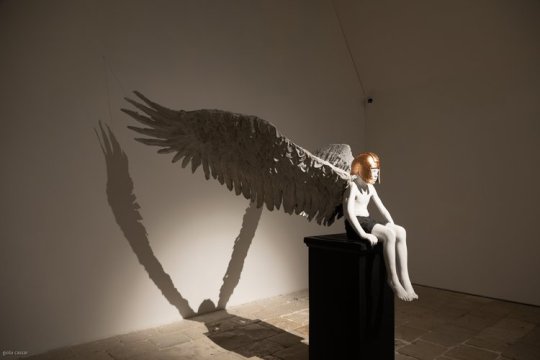
Installation featuring sculpture of the artist’s son
This installation features a real-life sized sculpture that represents the artist’s son diagnosed with Type 1 diabetes, along with a real-life glucose monitor connected to a TID warrior- measuring the child’s blood sugar levels in real life. The works acts as an inspiration from the myth of Icarus’ father Dedalus, as he warns him ‘’not to fly too high nor too low’’ – so that his wings would stay in place. This story of ambition is transcribed into an artistic visual by Calleja, as he not only depicts his own portrayal of his son’s chronic condition but also connects it with the myth of Icarus – reflecting the living harsh realities of his son.
'Faith IV' by Clint Calleja, 2023.
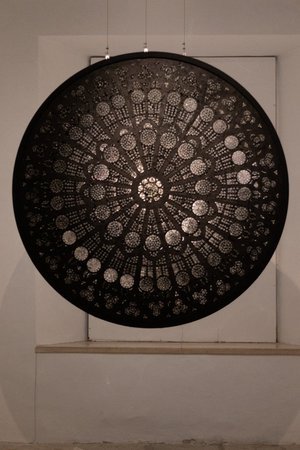
Oil on wood featuring a montage of insulin needles
The circular design of this piece is composed entirely of insulin needles which are ‘’the order of the day’’ of the artist’s son. They appear arranged orderly to form intricate patterns and symmetry of a traditional rose window. The needles symbolize more than just something medical- each one represents a real moment in the artist’s son’s life – recording his diabetes management through a relentless daily routine.
References: Calleja, C. (2025). Clint Calleja. [online] Clint Calleja. Available at: https://www.clintcalleja.com/projects/anamnesis4 [Accessed 2 Jan. 2025].
0 notes
Text
INTERPRETATION
‘Guernica’ by Pablo Picasso, 1937.
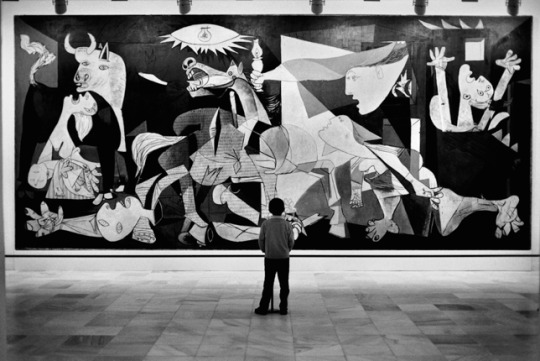
Historical context, cultural symbols, personal response
HISTORICAL CONTEXT-
Picasso created this artwork as an anti-protest piece in response to the bombing of Guernica by the Nazis during the Spanish Civil War. In 'Guernica', Picasso recreates this event into his art to depict the tragedy of the civilians. It acts as a response to Guernica’s innocent civilians experiencing this bombing and suffering- trapped, injured and unable to escape. This artwork is more of a provoking, political work and represents an anti-war statement.
CULTURAL SYMBOLS-
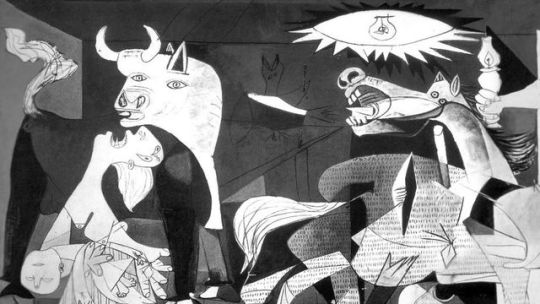
The symbolism used by Picasso clearly suggests the suffering of the civilians. The jumbled shapes and fractured images define the destruction and the horrors of the war. The chaotic shapes represent the ruins not only of the village of Guernica, but also the agony of the women. The disfigured horse in the middle of the painting may represent the suffering of all civilians- fighting for survival. The bull might have been a representation of fascism yet also something more personal to the artist himself. The dove which is depicted small and covered by darkness - may suggest Picasso’s rendition of the end of peace.
On the far left of the work, Picasso also incorporated a known motif of the Western art- the distraught mother holding her dying child, depicting the Pietà.
READER RESPONSE THEORY-
There is no intrinsic meaning of the work- as it only serves as a catalyst for interpretation.
PERSONAL RESPONSE-
Although there is no intrinsic meaning of the work, at first glance I almost feel chaotic to its overwhelming size- as if I am experiencing the agony of the figures in the picture. The imagery used expresses such dark emotions of suffering, loss and pain- reminding us of our humanity. I beleivce the monochromatic palette of blacks, whites and grays symbolizes further the tragic and dark period- eliciting outrage feelings. Also, the fragmented composition and disoriented forms evoke a sense of helplessness in the midst of a violent atmosphere.
References: Emptyeasel (2018). The Meaning behind ‘Guernica’ - Pablo Picasso’s Most-famous Cubist Painting. [online] EmptyEasel.com. Available at: https://emptyeasel.com/guernica-famous-cubist-painting-by-pablo-picasso/. Madrid Discovery (2024). Guernica, 1937 Pablo Picasso, history and analysis. [online] Madrid Discovery. Available at: https://madrid-discovery.com/guernica-pablo-picasso-analysis/.
0 notes
Text
DEMONSTRATIVE EXERCISE
'Nighthawks' by Edward Hooper, 1942

DESCRIPTION-
A scene happening at night in a diner in an empty, urban street. The artist uses a lot of cool tones- blues, reds. The scene depicts a bar with three people inside as customers- two of which are men in dark blue suits, and one of which is a woman in a red dress. The other person is the bartender of the bar and is wearing a white uniform. The leading lines of the shop and street are straight. The lighting is artificial and it is night time.
ANALYSIS-
The scene happening inside appears brighter than the dull empty street outside- creating contrast between the two. The composition and the perspective lead your eyes to the right- specifically to the man sitting on the stool. The colours oft he composition appear in harmony visually and the palette is quite restricted to cool blues, reds and greens. The outdoor is relatively dark. There is also sharp use of lines which represent the structured sharp angles.
INTERPRETATION-
Superficial theme: diner at night, artificial inner lighting, empty urban area.
Isolation theme: melancholy feelings. The mood created in this work is an eerie and mysterious one. This is influenced by the use of colours and light, as well as the fact that the rest of the shops in the street appear to be closed. The harsh interior light contrasts sharply with the surrounding darkness. A lonely and somber feeling is evoked as the man is sitting to the side, alone. This further highlights this figure - leading the viewers to focus on him.
Symbolism in composition: the composition itself may hold meaning. The counter of the bar acts a physical barrier that separates the figures. The large glass window creates a boundary between the diner and the night outside. This might also symbolize the people’s loneliness. Hopper places us outside the diner looking in- and leaves the story open-ended. The lack of clear narrative invites multiple interpretations- prompting viewers to project their own stories onto the scene- which might also represent the anonymity of urban life.
JUDGEMENT-
Personal resonance and viewer connection: I feel that the scenery depicted elicits a memorable and evocative mood along with its ambiguous narrative. Perhaps this may be relatable in its portrayal of modern life.
Cultural and social relevance: This work has become emblematic of a certain experience of urban American life. This is quite quirky as a scene in New York as usually, nightlife in New York is busy and chaotic - so this further highlights a loneliness theme (Witek, 2019). The use of colour is effective as it adds to the emotions experienced. The artist puts the figures in the scene on display as the onlooker peers into the shop’s window. This successfully adds to the feeling of eeriness and emphasizes the feelings of the loneliness of the man in the scene, which seem to be that of hopelessness.
References: Witek, D. (2019). Artwork Analysis: Nighthawks by Edward Hopper | Artsper Magazine. [online] Artsper Magazine. Available at: https://blog.artsper.com/en/a-closer-look/artwork-analysis-nighthawks-by-edward-hopper/ [Accessed 10 Jan. 2025].
0 notes
Text
COLOUR AND PALETTE
‘The Hay Wain’ by John Constable, 1821.
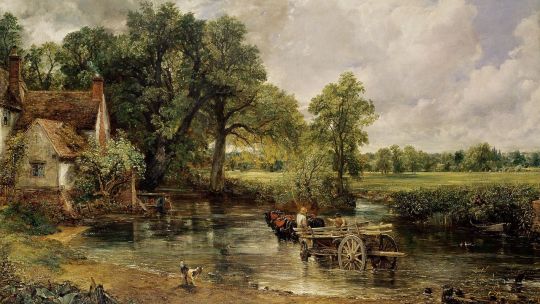
This landscape painting is an oil on canvas painting done in the Romanticism period. It depicts an idyllic, naturalistic country scene. The Hay Wain depicts a cloudy yet sunny rural countryside day with a river streaming into the composition between the background trees. The colour palette is very limited to earthy colours like browns, greens, and blues with some yellows and whites. The colours used appear very unsaturated - which in turn create an overall colour harmony (Scott, 2019).
The dark greens and browns of the trees create a subtle contrast against the light blue of the sky and white of the clouds. There are also some hints of reds and deep browns - which in turn give some warmth to the landscape. All of these tones combined suggest a sense of depth and distance (Welford, 2021).
References: Scott, D. (2019). A Closer Look At The Hay Wain by John Constable. [online] Draw Paint Academy. Available at: https://drawpaintacademy.com/the-hay-wain/. Welford, J. (2021). The Hay-Wain, by John Constable. [online] Geeks. Available at: https://vocal.media/geeks/the-hay-wain-by-john-constable [Accessed 10 Jan. 2025].
0 notes
Text
SUBJECT MATTER
‘Mona Lisa’ by Leonardo da Vinci, 1503-1506.

SUBJECT MATTER-
This portrait painting is a High Renaissance oil-on-panel painting that depicts a woman believed to be the wife of a Florentine merchant (Zucker and Harris, 2017). It is a half-length portrait of this woman in a seated position. Her arms are crossed and hands are folded- traditionally symbolising marital fidelity. Her attire is dark, thin and opaque. The dress she is wearing is quite traditional, not elaborate and is characterised with its wide neckline. Her hair is loose with curls that fall over her neck. Her head is also covered by a transparent veil.
All of this is complemented with the woman's mysterious gaze. Her smile appears elusive yet captivating - as if she is aware of her audience. This is achieved through Da Vinci’s sfumato technique - which furthermore gives that mysterious and hazy atmosphere in this painting. Behind the Mona Lisa one cannot miss the idealized, distant landscape that is also made with sfumato. The setting appears as a valley with rivers and cliffs that fade into icy mountains. This mountainous landscape is characterised with paths, and also a bridge over a river in the right half of the painting (Mirkovitch, 2019).
References: Mirkovitch, M. (2019). Artwork Analysis: The Mona Lisa by Leonardo da Vinci. [online] Artsper Magazine. Available at: https://blog.artsper.com/en/a-closer-look/artwork-analysis-the-mona-lisa-by-leonardo-da-vinci/. Zucker, S. and Harris, B. (2017). Mona Lisa. [online] Khan Academy. Available at: https://www.khanacademy.org/humanities/renaissance-reformation/high-ren-florence-rome/leonardo-da-vinci/a/leonardo-mona-lisa.
0 notes
Text
The Feldman Method
‘Death and the Maiden’ by Laurie Lipton, 2005.
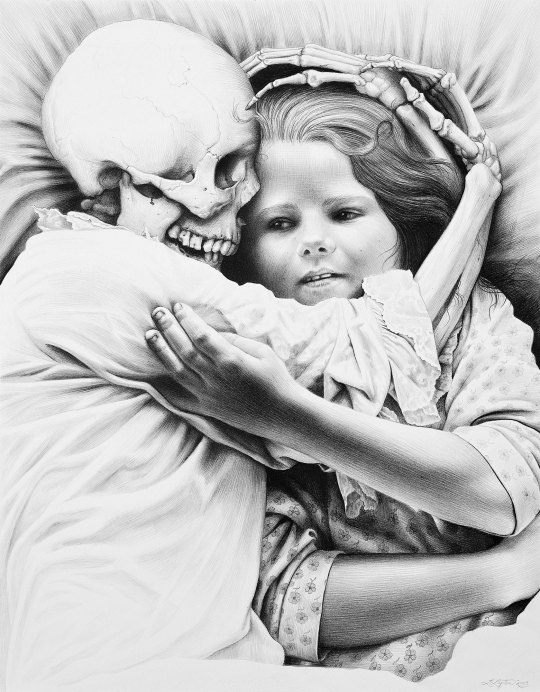
The Feldman Method is based on four stages of analysis which allow artistic works to be interpreted, judged and evaluated (Alashari and Bahru, 2022).
DESCRIPTION-
This drawing is a hyperrealistic pencil drawing that shows a high level of detail. A young, beautiful calm girl appears lying in bed, together with a skeletal figure that is cradling her gently. The drawing is monochromatic, and realistically detailed yet also appears visually haunting. The figures are positioned closely together- emphasising intimacy. The mood is a bit strange- unsettling yet warm at the same time- and most probably suggests themes of morality and death.
ANALYSIS-
Lipton uses fine lines to create the different textures of the drawing- soft marks to reflect the girl’s skin and hair, and sharp marks to represent the skeleton. The meticulous shading is what creates depth and realism. The use of lights and shadows highlight the girl’s warm expression and the dark contours of the skeleton respectively. This furthermore suggests the theme of life and death through the stark contrasts of the lights and shadows. The embrace between the two also creates a sense of unity- directing the viewers’ eyes from the girl’s face to the skeleton and back around.
INTERPRETATION-
The drawing suggests the relationship between life and death, intimacy and inevitability. The calm expression of the girl suggests acceptance of death- challenging the traditional notion of the human’s inescapable death. The emotions evoked appear as mixed ones; discomfort from the stark death, yet also embracing peace. The title also acts as a motif as it dates back to medieval art- symbolising youth and beauty. However, in this drawing Lipton modernizes this through a more contemporary aesthetic.
JUDGEMENT-
I think the artwork is both emotionally and technically powerful. The meticulous detail, use of contrasts, and symbolism make it more appealing to the viewer. Lipton creates a modern view from a classical motif by combining realism with surreal elements. This is what in my perception creates an impressive work- leading viewers to face their fears on mortality and death.
References: LAURIE LIPTON. (2019). DAY OF THE DEAD - LAURIE LIPTON. [online] Available at: https://www.laurielipton.com/day-of-the-dead/#jp-carousel-1290 [Accessed 2 Jan. 2025]. Alashari, D.M. and Bahru, J. (2022). THE SIGNIFICANCE OF FELDMAN METHOD IN ART CRITICISM AND ART EDUCATION. [online] Available at: https://www.researchgate.net/publication/360181296_THE_SIGNIFICANCE_OF_FELDMAN_METHOD_IN_ART_CRITICISM_AND_ART_EDUCATION.
0 notes
Text
ELEMENTS AND PRINCIPLES OF ART PT.2
‘Composition with Red, Blue and Yellow’ by Piet Mondrian, 1930.
In this work, Mondrian uses lines as the primary organizing element of the composition.
The painting appears made fromstraight horizontal and vertical black lines that form a grid structure. This is what divides the canvas into sections – establishing harmony through order - which is something that Mondrian believed in eliciting through his works.
The lines all appear aligned to right angles- creating a sharp framework. The horizontal lines appar to be suggesting stability whilst the vertical lines most likely suggest direction. Together in this composition, the variation of lines create balance and rhythm- reflecting Mondrian’s belief in balance and rationality.
When analysing the visual components in detail, one may notice that some of the continuous lines are slightly thicker in weight than others- this adds more subtle variation and depth within the work.

Ultimately, Mondrian’s use of LINE in this work goes beyond aesthetics. His style of abstraction through lines and primary colours conveys his ideals of order, simplicity and universal harmony.
For me personally, LINE is crucial when creating art. Not only lines make up the base of art, but also provide structure and order to a composition. Without lines, there will be no expressive energy in an artwork. The way lines are used may express such emotions directed to the viewer – whether lines appear curved, jagged, or straight.
With the use of lines, I believe that artists can direct the viewer’s focus to their personal artistic vision- whether this is through composition visuals or suggesting their emotions.
References: Barcio, P. (2018). The Transformative Power of Mondrian’s Composition with Red Blue and Yellow | Buy the Best Curated Contemporary Abstract Art | Free Worldwide Delivery | Ideelart. [online] Ideelart.com. Available at: https://www.ideelart.com/magazine/composition-with-red-blue-and-yellow.
0 notes
Text
ELEMENTS AND PRINCIPLES OF ART
In art, the visual terms are separated into the elements and the principles of art. The art elements are what act as the building blocks of any artwork whilst the principles of art are the structure that holds the basis of an artwork together (Chatt, 2022).
It makes you wonder how viewers analyse artworks deeply to understand their meaning- yet most of the time this is guided by the use of elements in an artwork like colour, line, texture, and shape. These elements are what help shape how we visualise the artwork, prompt questions and also induce emotions. They also help give structure to an artwork- in turn allowing the viewer to interpret and connect with an artwork even more.
I believe that all artists should have a basic knowledge of all art elements and principles. Although some art principles are more important than others, they are what help create an engaging composition when used in a good sequence.
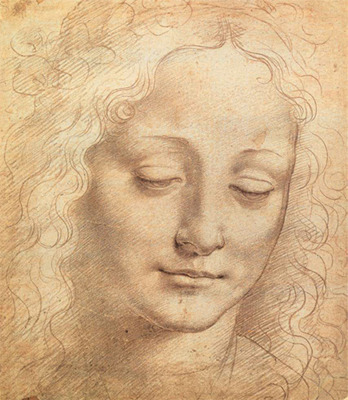
References: Brown, N. (2024). Library Guides: Design Fundamentals: Elements & Principles. [online] guides.lib.berkeley.edu. Available at: https://guides.lib.berkeley.edu/c.php?g=920740&p=6634741. Chatt, K. (2022a). Principles of art? NOT to confuse with elements of art. [online] The Art and Beyond. Available at: https://theartandbeyond.com/principles-of-art/. Chatt, K. (2022b). The 7 Elements of Art? Learn How To Upgrade Your Artworks Right Now! [online] The Art And Beyond. Available at: https://theartandbeyond.com/what-are-the-7-art-elements/.
0 notes
Text
HOW MIGHT AN UNDERSTANDING OF ART CRITICISM INFLUENCE YOUR INTERACTION WITH AND PERCEPTION OF ART IN THE FUTURE?
Art criticism is not just a skill, but also a mindset (Garrard, 2013).
It requires our interest, and critical thinking respective to the subject being critiqued. With art criticism, I believe that our appreciation and understanding of art will be improved. I believe that learning the principles of critique will help us analyse works thoroughly - observing such subtle details and complex choices of an artist.
Since art criticism influences highly the public perception and market trends, this in turn will reflect the success or failure of an artist or artwork. Critics’ opinions can also persuade the art world in many ways, and such theoretical frameworks may provide different perspectives through which art is analysed and appreciated (Sagal, 2024).
I believe that future interactions with art become more meaningful as art can be interpreted on a deeper level- connecting critical analysis with one's personal perception of art.
References: Garrard, P. (2013). Art is not a skill it’s a state of mind. [online] Of-course-blog.co.uk. Available at: https://www.of-course-blog.co.uk/2013/08/art-is-not-skill-its-state-of-mind.html [Accessed 10 Jan. 2025]. Sigal, N.M. (2024). The Role of Art Criticism in Shaping Public Perception and Market Trends. [online] 3(2), pp.37–41. Available at: https://www.researchgate.net/publication/383084109_The_Role_of_Art_Criticism_in_Shaping_Public_Perception_and_Market_Trends [Accessed 20 Dec. 2024]. StudySmarter UK. (2019). Art Criticism: Definition & Techniques | StudySmarter. [online] Available at: https://www.studysmarter.co.uk/explanations/art-and-design/art-and-design-theory/art-criticism/ [Accessed 20 Dec. 2024].
0 notes
Text
IDENTIFY WHAT ART CRITICISM IS AND HOW IT CAN CONTRIBUTE OR DEVELOP ART/ARTISTIC PRACTICES?
Art criticism has likely originated with the start of art itself. It can be described as the reflective interpretation of art that explores not only its meaning, but also its techniques, and social context (Martinović, 2017).
A definition of art criticism that I find very compelling, that is quoted by Martinović (2017) comes from the French philosopher Paul Valéry- who described it as "a form of literature that condenses or amplifies, emphasizes or organizes, or tries to harmonize all the ideas that arise when one encounters an artistic phenomenon".
With this definition, I believe that art criticism does not mean that art is criticised solely through negative opinions but also through a positive appreciation. Hence why the art world requires art critics. Art critics help shape one’s understanding of art through thorough analysis, as well as adopt significant discussions between one another - which in turn broadens our own judgment of art, both socially and culturally (Coates, 2023).
youtube
References: Coates, G. (2023). Art Criticism: Understanding and Evaluating Contemporary Art. [online] Naturalist Gallery of Contemporary Art. Available at: https://naturalist.gallery/blogs/faq/art-criticism-understanding-and-evaluating-contemporary-art [Accessed 20 Dec. 2024]. Martinović, J. (2017). What is the Purpose of Art Criticism Today? | Widewalls. [online] www.widewalls.ch. Available at: https://www.widewalls.ch/magazine/what-is-the-purpose-of-art-criticism [Accessed 20 Dec. 2024].
0 notes